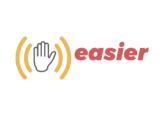In the rapidly changing field of sign language technology, there is often a gap between hearing developers and the deaf communities they aim to serve. While advancements like sign language machine translation hold great potential to be of use to deaf people, many of these technologies end up missing the mark, due to lack of partnership and collaboration with deaf communities. When considerable funding is channelled into projects that ultimately prove either ineffective or inappropriate, it is regarded by deaf communities as a waste of money.
The EASIER project has broken this cycle, by involving deaf partners and centring co-creation in technology development. The European Union of the Deaf (EUD) coordinates the project’s collaboration with end-users, with a comprehensive strategy to engage deaf communities. To achieve user-centred design, EASIER has taken three key approaches: 1) initial consultations to guide technology development, 2) multiple evaluation rounds to gather feedback on work-in- progress and 3) internal collaboration among deaf and hearing project members to ensure high-quality standards.
Initial Consultations to Guide Development
At the very start of the project, we consulted with deaf end-users to learn about their expectations, concerns and vision for sign language machine translation. Key insights from communities were clear: deaf communities view Sign Language Machine Translation (SLMT) as one potential tool among many—useful but not a complete solution to the complexities of communication. Most important is that SLMT is not imposed on deaf communities, and particularly not put to use in sensitive areas such as medical or legal domains. EUD communicated the opinions we collected to the technology developers, allowing us to effectively shape the project’s scope. By leveraging the technology’s potential against real needs expressed by the communities, the project defined relevant and potential use cases for the EASIER sign language machine translation technology.
Multiple Evaluation Rounds for Continuous Improvement
The project has also gathered user feedback on the technological components, through multiple cycles of evaluation during the development phase. In these evaluations, we presented users with different parts of the EASIER technology, such as the avatar or mobile app, and asked users to rate their performance. We also conducted in-depth focus groups to understand how to effectively improve these technologies in line with user priorities. The feedback we collected led to tangible improvements. For example, the avatar now exhibits clearer mouth postures and more natural body movements, directly as a result of our focus group feedback. In the mobile app, we improved the click flow in line with detailed feedback from our interim evaluations.
Harnessing Expertise: An Inclusive Approach
Thirdly, throughout the development phase, the inclusion of deaf professionals from different deaf European communities as project members has allowed us to leverage both lived experiences and considerable expertise on accessible design. The EASIER partners are in constant internal communication about how to ensure all aspects of the technology can match the diverse needs of deaf communities. These ongoing exchanges have resulted in more inclusive technology; for example, optimising colour contrasts and settings to ensure our app and avatar are user-friendly to deafblind signers, and those with low vision.
A blueprint for Inclusive Technology
In sum, the EASIER project offers a blueprint for how technology can be developed effectively and inclusively. Rather than merely ticking off boxes on an accessibility checklist, the project goes a step further by delving into what deaf people actually need and prefer. The clear takeaway is that tech solutions must be developed in collaboration with their intended users. In a world that often talks about the importance of inclusivity, the EASIER project shows that the key lies in authentic collaboration with deaf communities, deaf experts and other stakeholders.

